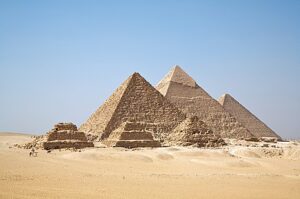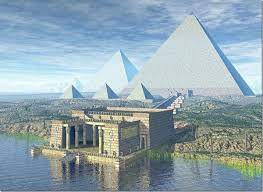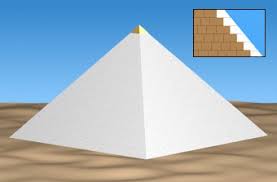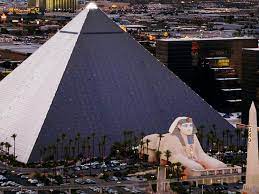Pyramids: The Perfect Gift for the Pharaoh Who Has Everything
We all know Pyramid schemes are bound to fail. Whether you’re undertaking a sketchy financial arrangement or undertaking a mummified pharaoh to his secret sepulchral chamber, pyramid schemes are an unworkable geometry. Why a nation-state should be in thrall of such a pseudo-religious structure is beyond me. However, I intend to reassess the bewitchery of these stony Jenga structures by examining the whys and wherefores of their construction set against the prevailing zeitgeist of 26th century BC Egypt. And, imitation being the highest form of flattery, I intend to construct my analysis precisely and deliberatively – piece by piece, stacking one belief atop the other until they form a really strong triangular argument with a point.
Ancient Egypt Wasn’t a Nanny State. It Was More of a Mummy State.
We can’t help but marvel at the majesty of the pyramids – their sacred vaults larded with gaudy treasures, their magically proportionate numerology hinting at supernatural intervention, and their cartoonishly detailed hieroglyphs heralding the advent of Pixar animation. These curious features all conspire to create a sense of breathless awe and baffling mystery. As Egyptology hobbyist Winston Churchill once said (and I’m paraphrasing here): “The pyramids are a mummy wrapped in a mystery inside of a really big shade structure.”
The greater mystery however, is in why a nation-state would allocate a whopping 99% of its GDP to build a really, really big headstone for a guy who would’ve been just as dead had a simple $50 grave marker been placed over his embalmed eminence. The resulting savings of $3 trillion (in 2500 BC adjusted dollars) could’ve been distributed a bit more beneficially to the citizens of ancient Egypt. At that time there were shortages of everything except sand. There were shortages of practical things like tourniquets, irrigation channels and roads. But the most critical shortage was one of common sense. Why else would Egyptians build these monuments to excess?
In the Egyptian scheme of spirituality, pyramids weren’t built so much to glorify a deceased pharaoh as they were to ensure his orderly transition of power from the earthly worlds to the nether worlds thereby avoiding the kind of afterlife chaos that could bleed into terrestrial realms. Happy King, happy subjects. In ancient Egypt this concept was known as appeasing Ma’at (Pronounced “Maw”, meaning divine order). Despite millennia of scholarly interpretation and rampant speculation, it turns out the mystery of pyramids was nothing more than a very big and very stupid insurance policy. And isn’t that essentially why many people practice religion today? Just in case there’s someone, somewhere with a ledger.
In a world where flooding, starvation and heat stroke were known as the prevailing conditions, the powers that be somehow thought it wise to divert 99% of their economic resources to stacking stones, on the pea-brain spiritual premise that by constructing such a geometric monstrosity, they’d be spared the wrath of their nature Gods. So they ponied-up literally a king’s ransom to appease these easily offended absentee Gods.
This is where the ancient Egyptians’ spiritual calculus breaks down. You see, if the flock was not paying proper respect to Ma’at and the pharaoh’s afterlife, they’d warrant a punishment for their misdeed. But in what manner would these absentee Gods punish their flock so they would feel the sting of their misbehavior? – by seeing to it that floods, starvation and heat stroke moved over the land? My point is, how would the peasants know the difference between experiencing the wrath of God’s retribution or just living under the prevailing conditions? Such irony when you can’t tell if you’re being punished or living the best life available. From this perspective, mollifying truant Gods by building resource-sapping pyramids presented an unmeasurable metric. You couldn’t tell if you were being punished or it was just Tuesday. Oh golly, such folly.
A Little Perspective. And if You’ve Seen Egyptian Drawings, You Know That’s Not an Easy Thing to Find in the Lower Nile
It’s fun and easy to satirize the pyramids. When they were built the earth was still flat, the sun revolved around the earth and we rookie Homo sapiens had been organized into large societies for only a few thousand years. Our Homo sapiens species developed in Africa about 250,000 years ago and we’ve been italicized ever since. Only in the past 12,000 years have we Homo sapiens evolved from nomadic hunters and gatherers to settled farmers and herders. This less transient lifestyle created a need for organization of which the Pharaonic Egyptian societies we’re discussing are an example. We weren’t good at organizing then. We’re better now, but we’re still trying – and the process is very trying.
We big-brained line of Homo sapiens (and that’s most of us, although we still have a few Neanderthals in our midst) have gained an ascendancy over nature for the time being. In 5000 BC however, it was a brilliant stratagem just to cultivate crops and to fool prey animals into letting us raise them in pens before we killed and ate them or drank their baby milk for our breakfast. With this agrarian model we were able to become more settled in our ways. It’s interesting to note that the sapien portion of our species name is a Latin word meaning “wise.” Just how wise we are is open for discussion, but compared to a caterpillar or a seahorse we’re pretty high up on the intellectual food chain.
Practical Pyramid Primer
There are 118 Egyptian pyramids and all except one are on the west bank of the Nile – seems the left bank is always the hippest. Most pyramids are concentrated near Cairo along an 80 mile stretch from Abu Roash to Lahun. I’m sure the inclusion of those 2 Egyptian cities helped you in pinpointing the area. The entirety of pyramid building took place during Pharaonic Dynasties from 2630 BC and 1520 BC. The tallest is the 481-foot Khufu pyramid at the Giza complex – the one you’re unknowingly most familiar with that has the Sphinx nearby guarding the necropolis. It is these pyramids that are one of the Seven Wonders of the Ancient World and they are the only Wonder that still exists today. In ancient Greek, the Khufu Pyramid is known as Cheops, and we’ll explore this pyramid more illustratively, in due course (I sound like William F Buckley).
In building the pyramids, the ancient Egyptians had no pulleys, no wheels, and, this being the Bronze Age, no iron tools. This was a decided disadvantage when quarrying, shipping and stacking big, heavy stones up to the heavens. The limestone was chiseled from quarries using copper tools. Much of the transportation of these leaden slabs was accomplished with sleds, barges and through the clever use of temporary inclined ramps. The motive force was provided, not by camel or horse power, but by man power.
Pyramid building was such an enormous bother for such a simple sandbox project that just got out of control. A couple of upside down pails of good sturdy sand and maybe an inscribed hunk of granite would’ve been fine to commemorate the phallen pharaoh. But the Pyramid-Industrial Complex and a few mortuary cult high priests got involved and the next thing you know 30,000 conscripted peons are slinging and stacking rocks all over the Sahara for 30 years. They really rocked back then – they had no choice.
The internal stones of the pyramids were the less impressive dark limestone and the capstones or finishing stone was polished white limestone that, once smoothed and buffed, shone brilliantly in the sunlight. Finishing limestone to a high sheen in 2500 BC was no mean feat. It was a painstakingly laborious process. The white limestone was polished with ever finer grit sands and water until the surface was highly reflective. Needless to say this job took a lot of grit and determination. Almost all of the finished limestone has been removed, repurposed and can be seen in various monuments and buildings around Cairo.
The labor pool for building pyramids was deep and varied. Imagine a combination of slave labor, conscripts and skilled artisans working in coerced concert with masons, engineers and mathematicians. Operating without any labor problems, management managed to get this over the top project airborne. By definition headstones are over-the-top – over the top of the decedent. But pyramids are both over the top and over-the-top – over the top in scope and over-the-top of the pharaoh.
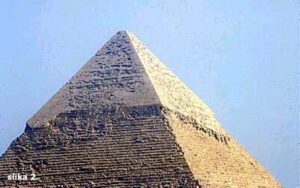
Khafra Pyramid at the Giza Complex, still sporting some of its original polished white limestone at the top. It has weathered in the intervening 4500 years. Who hasn’t?
Khufu is the largest pyramid ever built. It’s also the sound I make when I sneeze – Khufu!…God Bless you. Khufu is 755 ft wide at the base and originally measured 481 ft in height before the top 30 feet of its polished limestone covering was repurposed. Just a little of the finished white limestone remains at the top of the Khafra Pyramid adjacent to Khufu (God Bless you!). Roughly 2.3 million blocks of stone were used in the construction of Khufu. Each block weighed approximately 2 tons (about as much as one Costco run) and were roughly 3 feet by 3 feet by 6 feet in the lower courses. I’ve done the math and if you laid all the slabs end to end it would come to about 2500 miles of stone (The Great Low Wall of Egypt?). The granite slabs used in sealing and roofing the pharaoh’s treasure laden burial chamber came in at a hefty 80 tons (roughly the weight of a fully loaded Boeing 737). And to think they moved these petro-hulks using only primitive ropes, sleds and ingenuity.
If geometry class taught me anything it’s that an equilateral triangle’s sides are all equal in length. The Pyramids at Giza are, in essence, 4 equilateral triangles laid against each other at 90° angles. The white finished limestone gave the pyramids an astonishingly smooth, flat, reflective surface – as if you could slide down its vast, sloped white exterior with nary a bump. It must have been a tempting sight for proto-skateboarders, as they imagined grinding down the full 755 foot run at the vertices. Holy cowabunga! I wonder if creative builders installed little mechanical speed bumps on all 4 vertices to deter just such skateboard shenanigans.
Let’s briefly contrast Khufu with the pyramid-shaped LUXOR Hotel in Las Vegas. That took about 2 years to build and is only a little smaller coming in at 646 feet at the base and 350 feet in height. The difference being people inside the LUXOR are alive and losing money, whereas people inside Khufu are dead and fabulously rich.
The God Stuff Always Gets So Complicated and Arbitrary
The religion of ancient Egypt was polytheistic. And in deference to a joke about polytheism I simply can’t resist: There was also a Middle Eastern religion that worshipped many Esthers – they were a polyester religion, although they also looked good in cotton. But in ancient Egypt there were a variety of polytheistic deities who were believed to reside within and control the forces of nature – deities that would not be ignored. Ra was the progenitor of all the Gods and was most closely associated with the sun who the Egyptians recognized as the giver of all life. Ra was portrayed as a human with the head of a falcon. So by definition this was a birdbrain religion.
The role of the “parishioner” was to sustain these gods of nature so that they could maintain good order in the universe. The citizens were in a double bind. Not only did they have to fear these gods, but they had to support them too – talk about your Stockholm Syndrome. These were very needy, high-maintenance gods the Egyptians created – real punitive bastards who were born with a silver paddle in their hands. They required a 500 foot tall graduated rock wall, that absorbed all the resources of the nation-state to build. And all this just to keep the rivers flowing and the sun shining. Such insecure deities. The poor Egyptians could’ve used a paradigm shift, but that didn’t come along until the Renaissance.
The pharaoh’s spirit was called ka and was believed to remain with his corpse after death. This is why the Egyptians never buried 2 pharaohs together – because 2 pharaoh corpses laid side by side would make ka ka. (This thing practically writes itself.)
The Reason for Building a Pyramid Kinda Makes Sense Abstractly, But it’s Still Really, Really Dumb
To reiterate, the rationale for building such a comically large pyramid for a pharaoh phatally aphlicted, was to appease the Egyptian Goddess Ma’at. The goofy idea being that if the deceased pharaoh had all he required in the afterlife, he’d be content to maintain the good order that Egyptian citizens supposedly enjoyed during his reign. But in a world where flooding, starvation and heat stroke were known as the prevailing conditions, how would they recognize what was retribution and what was just the prevailing conditions? How would they know they were experiencing the wrath of their nature Gods or just life as they knew it? They wouldn’t. And that’s why pyramid schemes were so blunderingly idiotic. Only Madoff made-off from a Pyramid scheme; and then only for a period shorter than the reign of the Boy-King Tut.
These Gods they were appeasing were the kind of do-nothing, people-manufactured anthropomorphic deities that sit on the sidelines waiting for their “children” to mess up so they can judge them. What made this dynamic doubly corrupt is that these Gods didn’t exist in the first place and in the second place, the Gods got to enjoy the trove of treasure hidden in the pyramids and all Joe Egypt got was a pouch of silt in his Kwanza stocking. As created religions go, this one was as skewed as the perspective of an Egyptian pictograph. That is, take all the riches of the people and lock them inside a big, dumb 4-sided triangle for no one to see or use or even borrow against. Despite this outrageous misallocation of the people’s resources, the benighted faithful still chanted triumphantly, “Rah, Rah!” I’m sorry. I meant they chanted “Ra, Ra!”
Who’s Green Lighting These Geometric Monuments to Imbecility?
By now you probably realize this think-piece is a latter day refutation of ancient Egypt’s royal funerary practices. But I’m no latter day saint (in fact I don’t even own a ladder). I’m just trying to find an effective way to critique a society that practices Pyramidal Armageddon. How do I soberly and legitimately discuss the sanity of a society where toilet paper and dentistry were unknown? How do you approach an organized troupe of Homo sapiens where sand was considered a carbohydrate? How? – one grain at a time.
A 3-Sided Equilateral Satire on the Pyramids
Side One
You Can’t Take It with You, But the Egyptians Sure Tried
The decision to move forward with these monuments to imbecility was undertaken at the highest levels; usually the Pharaoh’s inbred family and a bunch of olive-skinned toadies with a financial interest in maintaining the Pyramid-Industrial Complex. Whereas in America the budgetary trade-off is between guns or butter, in ancient Egypt it was spears or hummus. The more things change…Right?
Egyptian lobbying groups promoted what was then known as the Healthy Pyramid Initiative. A flood of lobbying groups ensured the Pharaoh’s councils would support these great and unproductive Public Works projects. Profit-driven companies signing off on sucking from Cleopatra’s public teat included:
-
- General Dynamics
- Specific Dynamics
- Really Very Highly Specific Dynamics
- The Masons of Cairo
- The Davids of Jerusalem
- The Housewives of Alexandria
- The Really Very Highly Specific Housewives of Alexandria
- Rocks Я Us – Operator of family theme parks
- Golf of Suez – This group is hoping that an attraction like the pyramids will really help business even though the entire course is just one big sand trap.
- Microsand – They wrote the operating system behind all the hieroglyphs
- The BLM – The Bureau of Lamb Management
- The NRA – The National Ra Association
- Triangle Shirt Waist Company
- Inclined Plane Solutions
- The Hemp Rope Corporation
- Slave Driver Temp Services
- Tesla
- The Rock and Roll Corporation and its subsidiary, The Sex and Drugs and Rock and Roll Corporation
Those that disagreed with the Healthy Pyramid Initiative referred to it as Pyramidal Armageddon. Opposition to the Pyramid-Industrial Complex broke down along predictable societal fissures:
-
- The Union of Concerned Opium Smokers
- Ben and Jabbar’s Iced Sand
- PETA – People for the Ethical Treatment of Assyrians
- Hennapeace – A precursor to Greenpeace
- The ACLU – The Assyrian Civil Liberties Union
- Pita – The other PETA. The bread
Side 2
Poetry in the Time of Sand. Or is that Poetry in the Sands of Time?
The Egyptian Beat Poet “Isis T” penned an opposition anthem to the Pyramid-Industrial Complex entitled Growl:
I’d rather peer amid, the pyramids,
than smoke cigarettes, amongst the ziggurats.
I am in denial about de Nile.
I desire for Cleo to pat me,
But instead Cleo-pat-Ra
Well Tut-Tut
Our God Ra shortchanged us – He gipped us. Yeah, Egypt all of us.
Side 3
Semantic Considerations of an Egyptian Kind
Sand was an Egyptian resource not in short supply. In a time of great famine, sand was the base of the Egyptian Food Pyramid. It was also their mattress, their pillow and their face scrub. Just above sand on the food pyramid was hummus. Conservative citizens grew hostile to hummus and some were outright hummus-phobic. They believed hummus was a gateway spread to becoming hummusexual.
One of the construction managers at the Giza complex was asked if he thought it would be a good idea to place a big stone cat with the head of a human at the entryway. He paused for a moment and responded, “I think it Sphinx.”
While I’ve mentioned that the Egyptians were polytheistic, their religious “practices” also involved pan-theism. Pan-theism meant they believed God best expressed his divinity in the kitchen through various types of cookware. Pantheism had a piece of cookware for everything under the sun: soups, sauces, and gravies. Where monotheistic religions believe in one God, pantheistic Gods essentially work for one executive chef responsible for all the meals served in the cosmic restaurant of life. These epicurean Gods could stand the heat so they stayed in the kitchen.
Serious Summation(s)
There is simple beauty, bracing truth and serene exactitude in geometric forms. That’s the plane truth. Faultless geometry demonstrates we can be perfectly ordered in the symmetrical world of forms. And that’s something gratifying to hold on to. Life however, demonstrates quite the opposite – that we are all too often perfectly disordered in our asymmetrical world here on earth. That’s also a plain truth. I can understand ancient Egyptians celebrating and finding comfort in pyramidal perfection. This type of incorruptible perfection acts as a bulwark against the raggedness of the human condition. In the main, reliable geometry relieves, fortifies and otherwise appeases an uneasy citizenry with its soothing, inviolable precision. Comforting dependability is where you find it.
Some religions encourage the faithful by saying, in essence, “Try angels.” Egypt’s polytheistic religion substituted a more geometric encouragement, “Try angles. Peer amid the geometry and try angles.” Of course the mortuary cult priest may have been actually saying, “Triangles. Pyramid, the geometry and triangles.” Sometimes life is how you parse it.
At the beginning of this piece I promised to examine the pyramids’ whys and wherefores. And I accomplished this while looking at them through the lens of the usual polarized 2-sided dualistic argument – to build or not to build. That is the question. I now realize I never considered the 3rd side to the triangular argument. I should have considered the hypotenuse. I was obtuse. It’s no use. I hope you’re bemused I refuse to make an excuse.
I polished many of these choice phrases to a high sheen so they’d stand out mightily against a sea of mediocre exposition. But centuries later when the brightest literary phrases I ground to such perfection have been picked clean by plagiarizers for use in other monumental essays, it is my fondest hope posterity is able to see how this composition was once a great and towering essay – a monument to sensible Triangularity. But even if it were to be picked clean by phrase robbers exposing the darker less numinous sentiments within, I hope it’s apparent to everyone, I did it all for Khufu! (God Bless you!)

